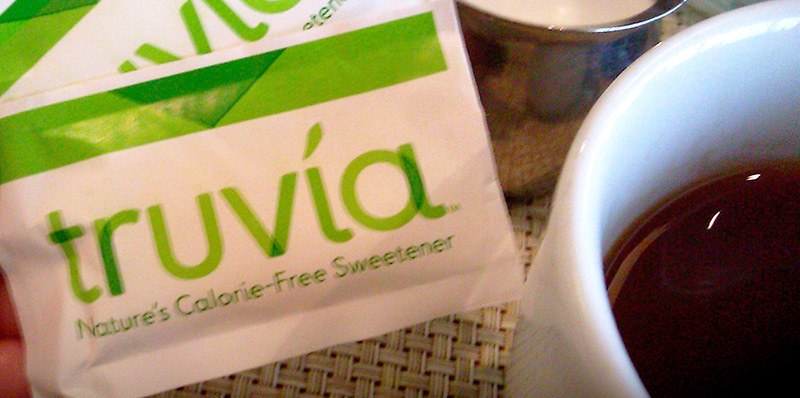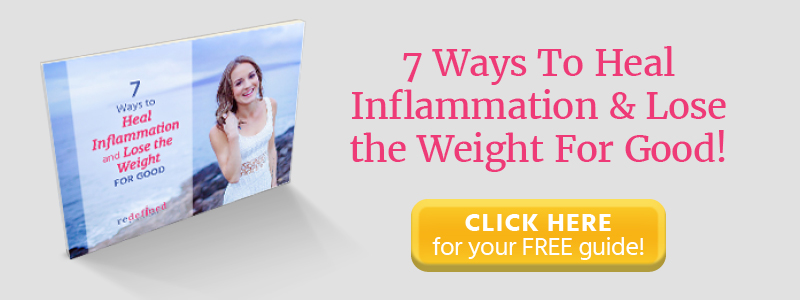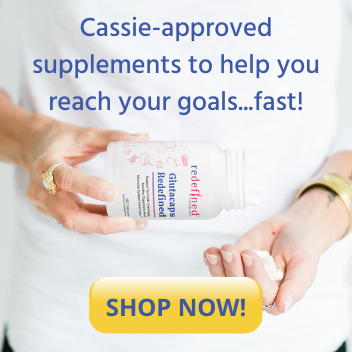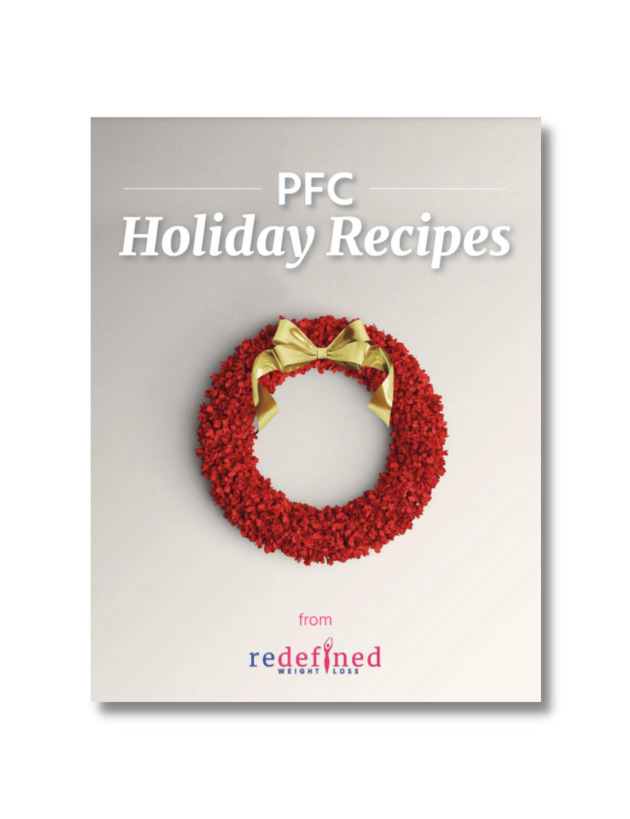Are Truvia and Stevia the same thing?
Thanks to a false-advertising job well-done, many health conscious consumers have been tricked into believing that Truvia is the same thing as Stevia. The (disappointing) truth is that, despite the fact that Truvia is marketed as a “stevia-based sugar substitute,” it is NOT equivalent to Stevia. Not even close, actually. Get this: the ingredient list for Truvia is as follows: Erythritol, Rebiana and Natural Flavors. Just three ingredients and Stevia isn’t even one of them! That right there should tell us something (for starters, not to trust the product manufacturer…which by the way is Coca-Cola teamed up with a company called Cargill…)
Let’s take a look at those three ingredients that make up Truvia:
1. Erythritol: A sugar alcohol which is made by processing genetically modified corn; this is the primary ingredient in Truvia. Sugar alcohols are notoriously known for their unpleasant side effects. Our bodies do a poor job at digesting sugar alcohols (which is why they are lower in calories), but because they aren’t completely digested, they hang out in our intestines where they are fermented by colonic bacteria. The by-products of fermentation include gastric distress, diarrhea, cramping, gas and bloating. Yuck. That’s ingredient #1.
2. Rebiana: Half of one percent of Truvia is Rebiana. The truth is that the only reason Truvia can mention anything about Stevia is because Rebiana is derived from a Stevia plant. But again, don’t be fooled. Rebiana is certainly not the same thing as Stevia. It is a molecule of the stevia plant. Furthermore, Rebiana is actually 400 times sweeter than sugar, but you’ll notice that Truvia is only twice as sweet as sugar. If you do the math, you’ll see that if a container of Truvia was divided into 200 parts, 199 of them would be Erythritol and only one would be Rebiana (which, again, isn’t even Stevia, but a mere molecule of the Stevia plant). In conclusion, Truvia is mostly Erythritol with a touch of a molecule of Stevia. Ingredient #2.
3. Natural Flavors. What does that mean? That’s a good question, and your guess is as good as mine. As you may already know, the term “natural” is not FDA-regulated, therefore there are no standards when using this word. Maybe this is why you’ll find the word “natural” all over the packaging and promotion of Truvia—on their products, website and advertising campaigns. This is a perfect example of how the term “natural” is used to deceive consumers, as nothing about Truvia is natural. The makers of Truvia are incredibly good at stretching the truth, along with other types of marketing deception such as using pictures of leaves and the color green on Truvia’s packaging and website, making it look “natural” and oh-so-similar to Stevia. It’s no wonder that when most people learn that Truvia and Stevia are two dreadfully different products they feel as if a bomb was dropped.
So, there you have it: the truth is that Truvia is a true sugar alcohol. Truvia is 99.9%pure genetically modified erythritol and less than a half percent of something made from Stevia—just so they can lie to you. If you dare, experiment at home and you’ll find that this highly processed sweetener doesn’t even taste like Stevia. Such a shame.
Now to address a few other misunderstandings:
- Sure, Truvia doesn’t have any calories (alike other artificial sweeteners), but that argument doesn’t hold up because it’s not all about calories anyway. New research is showing that because your body can’t figure out how to metabolize these sweeteners (which is the very reason they contain no calories), they are likely interfering with your metabolism and causing weight gain. This explains the phenomenon of people making a complete switch from sugary foods and beverages to artificially sweetened ones, yet not losing a single pound. So, please set aside the calorie argument when you are deciding which sweetener to use. More of my thoughts on why I hate calories here.
- Yes, I do realize I’m telling you not to use Truvia, even though the Food and Drug Administration deems it to be “safe,” but I wouldn’t put my health in the FDA’s hands. They recognize other artificial sweeteners as safe too, but none have been around long enough to see long-term effects. With many, we are already seeing abundant cases of adverse effects in the short term including migraine headaches, weight gain, gastric distress, diarrhea and vertigo.
- While I’m touching on Truvia, I might as well touch on a few other sugar substitutes that have recently appeared. PureVia is Truvia’s archenemy, made by Pepsi Co. of course, and you can guess I’d skip that one too. Nectresse is brought to you by your favorite makers of the chemically-laden Splenda (read my opinion on Splenda, here). You’ll never guess Necresse’s main ingredient: the same one as Truvia, the lovely (sarcasm alert!) Erythritol. And as a side note, in addition to Erythritol, the other common sugar alcohols include maltitol, sorbitol, isomalt and xylitol. Just keep it simple and avoid them all.
Then what should you use?
Your best bet is to use real sugar, pure Stevia (ingredients are as follows: Stevia), pure Stevia drops or my absolute favorite: Fruits & Greens Redefined (a whole foods powder, sweetened with Stevia). There’s virtually no health advantage to using honey, maple syrup, brown sugar, raw sugar or agave nectar. They are all metabolized as sugar and are isocaloric with the exception of agave nectar, which is 1 ½ times sweeter than sugar, and also contains 1 ½ times the calories as sugar (so you’d better be using less of it than if you were using sugar!). Sugar, Stevia and Fruits & Greens Redefined are the only sweeteners I will use in my coffee or food.
In summary, because of the recent awareness that sugar is harmful to our bodies (which really shouldn’t be a surprise), there will continue to be more and more of these “miracle products” appearing. Everyone wants a “quick fix,” so naturally (pun intended), these products will look, sound (and maybe even taste) promising. Don’t be fooled. Play detective by reading your labels, and, when in doubt, don’t put it in your body. Stick with less of the “fake stuff” and more of the “real stuff.” For a roadmap on playing detective, grab my bestselling book.
Click to download the free guide to learn the 7 simple ways to heal inflammation and melt away those unwanted pounds.













Very helpful info! Thank you!
Thank you. I’ve been using Truvia and feeling good about it, but I’ll stop now. You make great points, depressing as they may be.
Thanks so much for this post. This is very helpful. I tasted Truvia and really disliked it.
This was very helpful.. I’ve been told to stay away from artificial sweeteners, but can use Stevia products, and I’m glad I didn’t buy any of this.. Thanks so much..
Thanks for the information. So good to know that Truvia is not the right alternative for me.
Wow,
Those little stinkers!!! How dare they trick us into believing what we want to hear!
Thanks for the wisdom, Cassie; keep it up!
~Sam
Way to go, Cassie!!! Finally, someone is speaking up re Truvia!! Greg worked 20 yrs. for Cargill and still gets their magazine. When I read their article sev. yrs. ago re all their excitement over this new product, I told him with strong feelings just what I thought of this sham! Just like you pointed out, Cassie, we do need to read labels and then google what we don’t know. I like to think that I have been a fairly good label reader for a long time, but I still get shocked when I happen to read a label of something that I have used forever and see a huge no-no in the list-just start with your so-called sugar free gum that you feel good about buying for your kids-ugh!!
And just a comment re agave nectar…..I have been reading that it is so highy processed that some even say that it is worse than high fruct. corn syrup.
Again, Cassie, great job and keep blowing that horn!! 🙂
Wow! I had no idea that they weren’t the same thing! My family uses truvia religiously thinking it is the healthy alternative.
Sorry, but your post does nothing to address the use of Truvia for people who want to decrease their carbohydrate intake because they are diabetic or pre-diabetic. Personally, I have no desire to lose weight and am totally ok if Truvia makes me gain weight, but I use it because I am trying to cut carbs. People need to evaluate why they are using a product in order to determine whether or not it is for them.
Thank you for that information. What should type 1 diabetics use?
For Type 1 diabetics or anyone who doesn’t want to get Type 2 Diabetes, I recommend sweetening with stevia and using less sugar overall.
Great article. Thanks so much for putting all of this information together!
Excellent article! We all have to get the r word out!!!
I was faked out!
This wonderful article sheds light on a very popular product! Thanks so much for the information! It is sad to know that there is no such thing as an honest company anymore, however!
I am so happy the hear the truth about Truvia!! I work very hard at staying slim & in shape at almost 60yrs old. Since I have added Truvia & Splenda for the last year or so, (also an addict to fake sugars, ALWAYS) I noticed stomach distention, bloating, on top of many unpleasant side affects!! But, I need help!! As far as Truvia, I use one jar (80 servings) in 2 days or 21/2 days, plus 40 packets of Splenda!! That is SO MUCH!!! How can I come off this crazy amounts?? Also, have always craved sugary foods!! HELP PLEASE!!
YES, sugar alcohols (like erythritol, the primary ingredient in Truvia,) cause so much digestive distress…YUCK! Based on what you’ve told me, I think you need to overcome your sugar addiction. I’m emailing you right now 🙂
I would love to hear your response to Nancy. I am a sugar addict too. I eat really amazing clean foods, and then I wreck them with sugar. It is so awful! I could use some major help!
I’d love to help you overcome your sugar addiction! Excited to possibly do some coaching with you! 🙂
Hi Nancy – I have been a sugar addict all my life and finally got sick of feeling sick all the time (a lot of the same symptoms you describe). I’ve been on a 21-day cleanse (day 10 today) supervised by my doctor and it’s remarkable — my cravings for sweets are pretty much gone. (Bagels with cream cheese, not as much.) 😉 You might want to check out a cleanse — although most Western docs think it’s hooey. My doc is a more holistic practitioner. For me it took extreme measures. The first few days were hard but so far I love the results and how I feel overall. A dietitian like Cassie might be a good person to consult as well. Don’t do it on your own though. Like everything else regarding your health, do your research, get support and do what’s best for you. Good luck kicking the sweetener habit! And Cassie — great article — you pretty much confirmed my suspicions about Truvia!
I would take all sugars, sugar substitutes and GRAINS (which are nothing but sugar, once inside the body) out of your diet. Eat more protein, and you’ll overcome the sugar addiction.
And more fat too (which is safe if your carbs are low, and so will not make you fat or ‘clog arteries’), which also lessens hunger. But not vegetable oils – coconut, cocoa butter, butter and cream are best – and tasty!
leanlevine – here’s how I backed off sugar (and I do not use any substitutes). I used to put 2 teaspoons of sugar in my tea. Slowly I started leveling off the teaspoon, put in 1 3/4, 1 1/2, etc. Now I put in one heaping teaspoon in a quart of tea (hot or cold) and it’s tastes just fine. Too much sugar now disgusts me. It’s a process of retraining your taste buds. Do it slowly and you won’t even notice when you are down to little or nothing!!
My name is Nancy also!! my story age & amount of Truvia & Splenda is the same!! WOW!! My weight is still low, am 5ft 5 inches tall and stay around 114 to 117 lbs, but I work out 2 to 3 times a week with some cardio & 1 hour of pretty intense weight lifting!! But I have been affected with the same stomach distention, and bloating, even with drinking lots of water EVERYDAY!! Using all these fake sugars for many more years than I would like to admit, but truly since the very 1st fake sugar came out around 50 yrs ago!! I have become more addicted to sweets, than I have ever eaten!! With the holidays here, it is even much more difficult!! I NEED SERIOUS HELP!! I will always let myself indulge with some sweet once in a while. But, I NEED SERIUOS HELP NOW PLEASE!!!! THANK YOU FOR YOU HELP!!
The more dangerous problem is that Splenda is an excitotoxin (it kills off your brain cells). So, if you don’t have a heart attack, you’ll end up with Alzheimer’s. For more info, read The Taste That Kills, by Dr. Russell Blaylock
Was shocked to read the fine print on the Nectresse label and was going to use Truvia or Equal until I read this article. i have also been using agave nectar thinking it is OK. I am a sugarholic and was so proud of myself for not using sugar, but now I don’t know what to do. To me, Stevia has a bitter taste.
I get migraines and mood swings from sugar, but not from honey as long as it is not cooked – which is when it breaks down and the body digests it like sugar. I seem to tolerate Truvia – but after reading this article – I will never buy it again as I do not want gmo’s in my diet… I will just continue to do without as I have done for the last 4 years… oh, and will try stevia and Dynamic greens. Thanks for this article!
I’m sort of stunned that people aren’t reading stevia product labels. If you buy ANY food item that comes in a package you need to read the label!
Agreed! 🙂
Thank you for saving me! You are a Godsend!
thank you so much. At a coffee shop they use truvia. i tried to read the label: curious… and now I know. You are the best for enlightening me. I typed on google: truvia: same as stevia? and I found you. You have to watch your step all the time. what a world we live in. again thank you, I will not use truvia anymore.. i try to carry my bottle of stevia with me, but sometimes i forget, i was so pleased to find truvia, became curious, and voila!!!
Hi Christine, I don’t recommend ever putting any artificial sweeteners (chemicals) into the body and that’s what the sucralose in this product is (better known as Splenda). Read more on my thoughts here: http://www.dietitiancassie.com/skip-the-splenda-and-all-other-chemical-sweeteners/
Hmm, the ingredients do not say sucralose, they say sucrose and all the websites I’ve researched say “Sucrose or table sugar is obtained from sugar cane or sugar beets” (direct quote from Elmhurst College – elmhurst.edu website). This very technical article goes on to say “Sugar or more specifically sucrose is a carbohydrate that occurs naturally in every fruit and vegetable.” Now I’m confused as a highly respected dietitian recommended this product to me and I thought I was doing something healthier. Thanks.
Oh no! I misread your first comment — I’m so sorry I confused you even more! SucRAlose is splenda and what its your product SUCROSE is sugar. So, that sounds like it’s just fine. Hope that helps.
But what is crystalline fructose, the first ingredient she listed? A couple of articles I’ve read indicate it’s essentially HFCS.
It is.
Big brands always make me a little suspicious, but dang, this is almost evil! Thanks for your post.
I recently tried coconut sugar. It has a brown sugar taste so its not good for everything but it is low carb and doesn’t have any after-taste. Nice addition to my SweetLeaf 100% stevia powder & liquid.
I was reading the ingredients the other day and had no idea what they were. Thanks!
I grow my own too.and just 1/2 leaf sweetens my tea just right!!
That was a Great Article and definatey clarified the confusion between “Stevia” and “Truvia”. Even reading the lables on Truvia was confusing and there is no glycemic index on the Truvia packing which is very important to me when choosing a different sweetner. Stevia on the the onther hand puts that information on it’s lable and I find it very helpful. Thank You.
Calvin
I wouldn’t recommend it at all. I would suggest using SweetLeaf pure stevia.
I switched from Equal to Trivia, and why am I looking at this site?? Because I gained 10 pounds in 3 weeks! This was the only thing I changed so I wanted too see if anyone else noticed a weight gain. Guess I’ll have to quit coffee all together ughh
Yes, I also gained some weight after using Truvia. Didn’t know why until now. Thanks for sharing.
Drink fresh coffee and gradually reduce the sweetener. I find I can enjoy my real coffee without sugar now, but the instant (fake) kind is undrinkable with out sweetening
A little late to the party, but the Truvia packet I am reading has ingredients listed as: Erythritol, stevia leaf extract, natural flavors. I understand erythritol is not good for you, that I can back.
Yep- Erythritol is the primary ingredient in Truvia, so I wouldn’t recommend it!
I wouldn’t recommend Erythritol, but it is up to you if you want to finish them. 🙂
Well, I’ve been using Truvia for a couple of weeks now, and have noticed that I constantly have diarrhea, something I’ve never struggled with before. I stopped using it immediately and will watch how I do over the next couple of weeks! Back to raw sugar for me.
Typical reaction to Truvia. Glad you made the connection! 🙂
Those “sugar substitutes”are absolutely useless,I’ve never lost an ounce when I switched.
I sent an e-mail to the Truvia company (today) and asked them what the percentage of Erythritol was in Truvia…since Erythritol was the first ingredient on the Truvia label of ingredients. Well, they came back with slick answer within a few hours…a “run around” at best…sighting privacy issues as an excuse. Then, I e-mail them back and asked why they don’t call the product Erythritol, since that is it’s main ingredient. I’m sure I will get another “run around”. I was very bothered by this misleading answer and VERY thankful I came upon this website.
Good for you, jim and cassie, i am sooo happy i stumbled on your page!
Yay me!
i have been warning my husband, type2 diabetiv, for years about these miracle sweetners!
now i am armed with the truth…not just my health preaching i do all the time!
he drinks diet coke like water and now he has to stop!
Thank you. I started drinking zero calorie Vitamin Water. Started having intestinal problems. Now I know why. No more for me!
My problem though is that Stevia is horrible tasting. Any know of a gooood Stevia that you can bake with now that the holiday are upon us? I don’t use grains so my foods will be cheese based. I have the Stevia with the little tiny spoon and man that after taste will ruin an entire cheese cake.
Just shared on FB and have to share here. Before I post I’ll say that I have no financial interest in any erythritol-based products. However I do help run a non-profit that assists pediatric cancer patients in eating healthier and we do recommend erythritol as a sugar substitute based on the scientific literature. Here’s what I posted to FB: “Cassie: I love your stuff, especially your podcasts with Jimmy Moore. But I hope you reconsider your position on erythritol. I’ve done a lot of research on it because we put our son on a low-GI diet two years ago and more recently on a KD. We looked around for the best possible alternative zero-GI sweetener and erythritol is it. Just because it’s part of the sugar alcohol family doesn’t mean that it’s exactly like all the other nasty sugar alcohols. It’s fully absorbed in the intestine so it doesn’t cause bloating, indigestion, etc. And it gets passed out unmetabolized in the urine. Bottom line: we’ve used it daily for two years and L-O-V-E it.”
Justin, pure stevia is still far safer…
3 studies on reproductive effects disagree that whole extract is safer then the purified forms of stevia. As far as erythritol goes I react poorly to it so I stay clear, but sugar alcohols are found in fruits at low levels.
I can vouch for the unpleasant effects of erythritol 🙁 . I suppose that it depends on the individual consuming it but in my case the results are not good and extremely malodorous. I’m not automatically against something because it’s manufactured but my family’s nostrils are grateful I stopped using it!
I find it ironic that you’ll use a product like Erythritol because there the FDA says it’s ok and you’ve “done the research” — but you’re using low GI diet which is still frowned upon as being “bunk” — Actually I find it totally bizarre that working with pediactric CANCER patients, you’ve decided that a sub like Erythritol is A OK – when we don’t really need sugar in cane, corn, or artificial form AT ALL and only in minute amounts per year from honey or maple syrup — I don’t care if you LOVE it for the last 2 years, it’s insane to me that anyone would put artificial stuff in their bodies to replace something that’s not even necessary — whether or not it’s metabolized AS SUGAR isn’t even the issue
Wow. Amber, this is an incredibly rude way of interacting with a complete stranger. In any case, my point was that of we are going to be guided by evidence, then we shouldn’t be as concerned about erythritol as we are the other sugar alcohols. The available research, such as it is, suggests that it’s perfectly safe even at relatively high doses. But the larger question is what is your goal? Now we have our son on a ketogenic diet as a cancer therapy and so the metabolizing of sugar is a very big issue. And by the way, it’s a very big issue for everybody in terms of heart disease, obesity, diabetes, etc. The facts: erythritol is zero on the glycemic index, has no GI problems for most people, and has been found so far to be perfectly safe. For us, and families we work with, it is invaluable in getting kids off of sugar and maintaining them on a therapeutic KD.
As an advanced practice nurse of many years I totally agree with you, Justin, on the Erythritol, the benefit of ketogenic diets for cancer to stop feeding the cancer cells with massive amounts of sugar, as well as the unnecessary rudeness. There are huge amounts of research related to both. I also thought Erythritol was one of the sugar alcohols bad for the bowels, but it isn’t. Here is an article reviewing the literature. Erythritol isn’t always made from corn, by the way, and occurs naturally in many fruits as they begin to ferment. I won’t go into the benefits of fermented foods. http://authoritynutrition.com/erythritol/
J-RN you being a nurse I was wondering how a ketogenic diet would work for a diabetic and also stage 4 kidney disease if I am not mistaken doesn’t that diet cause acidosis. if so how would that effect your Kidney?
Having had a recent close encounter with LDBCL (cancer), I can back up what Justin is saying. I’ve worked closely with a naturopathic nutritionist who specializes in cancer patients, since achieving complete remission. This woman works in conjunction with the Odette Cancer Centre, one of the best in Canada and one of the top in the world for hematological cancers. What I have learned from her is that the number one food for cancer is glucose, no matter what its source. Cancer patients, both those with active disease and those in remission, must stay on a low GI diet, so as not to spike blood glucose. The LGI diet along with extended moderate daily exercise is the best way for anyone to keep blood glucose levels low. As part of my low sugar ( from all sources), low fat diet, I’ve decided to use xylitol as a sweetener, rather than stevia, for two reasons. One, I hate the taste of stevia. Two, I only use sweetener in my morning coffee.
As for berating Justin, first you show incredible insensitivity toward someone trying to deal with a devastating situation. Your horse must be high indeed if you can’t at least be gentler when spreading your own brand of bunk. Yes, no one needs to use sweeteners, but try to raise a child already burdened with the often unpleasant treatments cancer patients must endure, and then deny him any of the treats he sees other children enjoy. And don’t suggest desserts be sweetened with fruit because most fruit is almost as sweet as sugar.
Ketogenic diets are showing incredible results, especially in brain cancers, when used in conjunction with medical treatment. So Amber, before you deal with as complex an issue as cancer, do a lot more reading. Not on any site, but on credible medical and scientific sites. You owe Justin a huge abject apology. Justin I wish your child a complete remission and you lots of strength.
The surprise for me is that people didn’t realise that Truvia was not pure stevia. Don’t people read packaging? I don’t have any issue with erythritol personally and am happier using Truvia than any other widely available non-sugar sweetener.
I think it’s because of the sneaky marketing tactics. They make the Truvia packaging look like stevia and the name sounds like stevia, which is why it’s important to be on the defense and read the ingredient list above all else.
why they bother offering Truvia in all the Organic supermarkets that I go to, even in the Organic coffee shops. This doesn’t make sense…
I made a wonderful smoothie yesterday or thought so till my stomach started cramping. Major cramps for 24+ hrs. Live and learn. Now I know why that smoothie backfired. It was the orange or the protein powder, nor the water. Truvia! I just shouldda known..
wow. they had me fooled. I thought Truvia was Stevia, and I just assumed that Erythritol was the nerd name for the Stevia plant.
hehe;) That made me chuckle.
where do you get the plant to grow your own?
I bought my plants a ace hardware in Owasso Ok. they are Perennial so you only have to buy them once. they grow very well. I just break off a few branches and hang them upside down untill the leaves are very dry. then take the leaves and put them in a coffee grinder and it makes a nice green powder, I have a three cup coffee maker and I just add 1/2 tsp of stevia on top of the coffee and let it brew it tastes great. If I add about a 1/4 tsp straight to your coffee it will sweeten it ok but it floats on top for awhile. before it sinks to the botom of your cup. it does not desolve.
The brand I use is SweetLeaf Stevia! 🙂
Love it 🙂
If sugar is harmful to our bodies why would you recommend it as a sweetener?
I don’t recommend consuming a lot of sugar, but I think a little bit of REAL sugar is a MUCH better alternative to Truvia or other sugar alcohols and/or artificial sweeteners. Your body knows how to process real sugar.
I’m new to clean eating and know good ingredients but not all bad ones. I just used 2tsps in my toffee and I am freaking pissed. I will be throwing out and replacing.
What about Swerve as a natural sweetener?
Unfortunately Swerve is the same situation as Truvia, Wendy. Primary ingredient: Erythritol.
I just came here to say you’re a bunch of bandwagon retards and the only people that shouldn’t be taking Truvia are the ones experiencing negative side effects such as diarrhea. Most of your problems are that you’re eating 40 packets a day and complain your having problems and its not Jesus sugar, well guess what, there’s no perfect sugar for bingeing. Truvia has no calories, it may make you bloated but that’s just how you really look.
Thanks this is clear information. I was reading happy hormones slim belly by Jorge’s cruise – I think I will stick with slow carbs for Tim ferris the artificial sweetners scare me. What do you think of almond and coconut flour ? Will it help?
I love both almond and coconut flour! 🙂
Cassie- thank you so much for the info on truvia! I used it but had a bad feeling about it- should have done my homework sooner. I’ve been off of sugar for three years but still get cravings- so I’ve quit starches & “whites” as well. Can you tell me if “Stevia in the Raw” is straight stevia?
appprove
Thank you for this! I just looked at your blog after watching you on TCL. I love it! What do you think of Stevia in the Raw (stevia & dextrose)??
I just purchased some Truvia and have consumed only 4 packets. Yesterday (#4) I noticed I became unexplainably irritated. I immediately suspected the Truvia as it was the only thing new and I am pretty tuned into my body. So I used real sugar this morning, did a search and here I am! Thanks for the information.
Great post Cassie & Karen; thanks for “the specifics”!
It’s a shame that so many people believe that Stevia and Truvia are one in the same. Then again, people are so easily fooled these days. Just look at who’s in the White House.
I have been using Stevia for over 2 years to sweeten my home made lemonade and green tea, among other things. I had a coupon for Truvia so thought I’d give it a try and I had the worst diarrhea last night after drinking my normal amount of green tea. The only thing I’d done different with my diet was Truvia. I immediately switched back to Stevia and now I’m fine. It was so sudden and crazy! I wasn’t nauseous or crampy. Just felt bloated and when I’d go to the bathroom it was like flippin Niagra Falls – like 5 times! It also didn’t taste as good as the Stevia I get at my health food store. Truvia is going in my trash can right now.
Hello! Thank you so much for this information! I was certainly being fooled! I thought it was worth pointing out, however, that refined white sugar is not really an acceptable substitute. I agree agave nectar is better, as long as you use less, and some less refined honey is better, mostly because they have a lower GI. Isn’t that what is important when concerning yourself with sweets? The GI!? Thanks for everything you do!
How long does Truvia stay in your body?
I was tricked into believing that Truvia is a good natural sugar substitute. Shame on you Cargill and Coca Cola!! I too look forward to their demise! Someday…
That’s great! Use whatever you want, Nancy. I’m here to educate, not police!
I had no idea. Thank you.
I used Trivia one time on my cereal and eight hours later I had gastric distress that lasted for twelve hours. I will never use this product again.
Thanks for this, I might add that ‘Truvia’ costs nearly u00a35 for a tub of it…..absolutely disgraceful that there aren’t stricter regulations were food and drink are concerned. I’m glad I read the ingredients before I bought this! I really thought it was going to be Stevia…just because it cost 5 times more than generic sweetener….which in essence is just what this is….ugh
I started using Truvia as a sugar substitute a few months ago thinking it was totally plant based. Lately I have been having pain in my sides went to my doc for a blood test and all was normal so thought it might be exercise related. Decided to investigate Truvia further because that is the only thing I have been doing differently and came across this web site a couple days ago. Saw what was in it, quit using it and guess what? The pain is gone. There is something terribly wrong with that stuff. If you check it is almost impossible to read the label without a magnifier under a bright light. Erythritol probably damages the liver over time and I am proof it is no good for the kidneys. This is obvious fraud.
Seriously? The Coca Cola company is continuing to make products because people continue to buy them. Most people know that sodas are bad for them, even the diet ones, but consumers still keep buying the products. Coke isn’t doing anything but providing what the public wants. Just like most fast-food restaurants, consumers know that crap isn’t good for them, but every now and then they just crave it. To each his own. If you don’t like sodas, don’t buy them.
I suppose you can say the same for drug dealers
Yes you can. You can also say the same thing about every fast food place, restaurant, candy shops, etc. Bad things are out there and people do have a choice.
While people have a choice, they should not be subjected to deceptive marketing tactics. Truvia’s packaging and marketing material imply that it is just like stevia, when we know it’s not. I know of at least 3 reasonably intelligent people who were fooled by it. We also know that Coca Cola has significant lobbying power. It is therefore, not only our choice, but our duty to make sure our lawmakers look after the public’s interests and intervene when deception is the name of the game. Let’s not pretend that the citizenry can easily navigate through all that deception, and neither should any company be allowed to have questionable marketing practices.
Right, market is out for themselves… People should also be out for themselves. When you buy something, it is 100% your choice. The market did NOT “make” you do it. They suggested, and you decided to act upon it. No body made one go a buy a pack of diet when they are well aware of the consequences.
The list of ingredients is long even in healthy alternatives, and researching each ingredient is very hard specially when I go online and I find an equal proportion of articles, blogs, news, “research”, both for and against the same stuff. This is a major problem for me and I am guessing many others.
not necessarily- not everyone is “well aware” of the consequences of diet soda- the public should not be deliberately lied to about the effects of poisonous ingredients in food and when powerful, hypnotic “suggestions” are inserted into your daily sources of communication, it is unfair and unrealistic to call your puchases 100% your choice.
just saying…..
NOT the same thing. People addicted to drugs will kill to support their habit. Don’t think there has ever been a murder related to Coca-Cola addiction!
I believe it is the sugar that is being craved it is about as addictive as most drugs
I started Truvia a week ago…. gi distress x 100… thought it was the same as Stevia. purchased 120 packets and will throw them away.
I knew it! I did read the ingredients and I wondered about the ethrytol, but went ahead and used it in my tea and eventually coffee. I knew something was up when I suddenly found myself craving all those snack/junk foods I’d been avoiding … plus adding MORE Truvia to my tea and coffee, because it tasted so ‘good.’ I was suspicious and so did a search and found this article. Thank you for the truth! I should have known better~!
The biggest problem I see with Truvia and other so-called healthy alternatives is the fact that many (or most?) contain processed ingredients. Since the chemicals used to process the ingredient aren’t directly put into the recipe, the FDA does not require that they be listed as an ingredient. For instance, Splenda is nothing but cane sugar processed with chlorine. Do you see chlorine listed as an ingredient of Splenda? No, because it is not actually a part of the recipe. Who knows what Truvia uses to process the erythritol. Canola oil is another good example of chemicals not listed. You will never find that stuff in my house.
However, there may be a good use for Truvia. It seems that a kid did a science fair project where he was feeding various artificial sugars to fruit flies. Most of the artificial sugars didn’t seem to have much effect, but the flies fed Truvia died after about one week. The kid thought he probably did something wrong, so he set up the Truvia part of his experiment again, being really careful about the food, so as not to contaminate it. The fruit flies died after in a week, again. It may be possible to use Truvia (or erythritol, the main ingredient) as an insecticide for flies. Of course, for use in humans it was declared as GRAS (generally regarded as safe), but for use as an insecticide it will have to go through a lot of testing.nThought everyone might enjoy the irony.
I would recommend pure stevia instead of truvia!
I use trim healthy mama sweet blend which is a non Gmo blend of stevia and eyrthriol it’s the best flavor profile and non GMO !!!
Great information and love the way you broke the information done. Thank you.
I have a mast cell disorder and had problems when I was using Truvia. It’s yummy, but I definitely can’t use it. It causes a reaction and that’s not worth it.
Rebiana is derived from stevia leaves. Sheesh.
Thank you for the awesome research, had no idea and i went to school for dietetics as well, should have known better! thanks again!
Maybe! But I wouldn’t recommend Nectresse (it’s main ingredient is the same one as Truvia, the lovely (sarcasm alert!) Erythritol.)
I’m not a fan of ANY sugar alcohols, including xylitol because of their negative effects on our GI system, but I know folks who love using this sweetener! Up to you.
After reading all this I am more confused than ever. I have been Type 1 diabetic for most of my life. As an adult I started out with the “pink packets”,then “blue packets”,then Splendia, now Truvia. So, what is the best artificial sweetener to use ??
Hi Debbie! It can certainly be confusing when we are given mixed information from the media and marketing from every angle! I’d encourage you to read this post I wrote for reasons why you shouldn’t use the pink or blue packets: http://www.dietitiancassie.com/skip-the-splenda-and-all-other-chemical-sweeteners/ and then stick with real sugar or stevia (Sweet Leaf is the brand I buy). Hope this helps!
I get a liquid stevia product made by Hermasetas, so that I can use it in cooking as well as drinks. 5ml is the same as 50g of sugar.
Blame? Nobody talked about blame, but accountability. If the current laws do not defend good principles they need to be changed. Laws usually change because of they no longer serve public interests. If Coca Cola is navigating through current laws in order to deceive the consumers, they should not be allowed to. What is unethical, in this case deception, is not always aligned with what is illegal, and this is why the lawmakers need to step in and disallow this.
That all sound well and good but these Large conglomerates can buy off the Food and Drug Commision and sell there junk.
It doesn’t mean we give up the fight. Yes the conglomerates are very powerful but they’re also vulnerable once exposed. Consumer protection organizations have scored many victories.
No wonder I have gained 7 pounds eating clean and excersing, only different thing I have been doing is using truvia … It’s going to the trash can!! ughhh
I’m gonna play devil’s advocate here just for a little balance… I’m hypoglycemic and a sugar addict and for years I’ve been using a combo of erithrytol (and now non-GMO erithrytol) and stevia as a sugar-substitute for baked goods etc., long before Truvia came out. From what I’ve read, erithrytol is the one sugar alcohol that digests differently than all of the others. My very sensitive gut confirms this. ALL of the other sugar alcohols give me severe intestinal problems, but NOT erithrytol, not even a little. I do believe that sugar-substitutes shouldn’t be used at all, rather one should take it all out of the diet so that your taste buds re-adjust to the natural sweetness of real food. However in a pinch, the stevia/erithrytol combo can work with the least damage and the sweets taste good but not great, which is built in portion control. I am wondering, however, it may be the “natural flavors” in the Truvia that are causing the addiction and gastric distress for those who mentioned it. MSG is highly addictive and often part of “natural flavors.” All this said I don’t and would not use Truvia. I can get ingredients from non-Monsanto sellers, and know much better, what I’m using.
I was surprised too!
Real sugar is NOT a good substitute for anything, really. It’s food for cancer cells and a host of other ailments, since it causes dietary and other imbalances. Even agave has the same effect. Sugar is sugar when it comes to your body processing it.
If I have an erythritol sweetened home made ice cream in the evening, I find I have to drink a lot of water at night, just as if I had eaten sugar sweetened ice cream. So, although all the evidence says that erythritol is low GI and low calorie, it certainly fools my body into wanting to treat it like sugar by diluting it with water, hence also causing me to pee more in the night. For this reason I now use only small amounts of it in conjunction with stevia, just to take the edge off the back taste.
if you use stevia powder instead to the liquid it doesn’t have much after taste especially if you put in on top of your coffee and brew it. Sometimes i put 1/4 tsp of sugar in my coffee that makes it taste like real sugar and is only 1 carb.
And now…they have a brand new product BEWARE The New Truvia® Brown Sugar Blend http://bit.ly/1AX5ONr Cargill is despicable.
I grow my own Stevia, also…Much better for you and of course, completely natural… A lot plant nursies are starting to carry it in the spring. Try it, it’s very rewarding to grow your own.
The research on this is inconclusive. I think Stevia is fine for those with hypothyroidsm. That said, there are plenty of things you should embrace and avoid to support your thyroid. My team and I help clients support their thyroid and metabolism through real food and would love to help you! Just email [email protected] and tell them you’re interested in how coaching can help you!
Then it’s not pure stevia!
Just made snow ice cream with TRUVIA as sweetener. I had to use several packages, and now I’ve had diarrhea several times. I don’t feel ill, so could it be the TRUVIA?
There’s a high possibility, due to the (icky) sugar alcohol!
My wife switched me over to Truvia a few weeks ago to put in my coffee at work. A few days later, I started to suffer from constipation. Not realizing that the Truvia good be responsible, I kept using it daily. I ended up in the hospital for two days with constipation so severe, that they thought I had appendicitis, and put me on morphine! Once out of the hospital, I still had no idea that the Truvia was the culprit, and the symptoms began to return. Since stopping the use of it, my bowels have cleared up, and I am back to normal. Truvia is poison!!
thank you! very helpful!
In the body, sugar is sugar is sugar.
I recommend the Sweet Leaf brand of stevia; http://amzn.to/1zd4FU7
That would be a lie… Do you know what the reasoning was for the recommendation to switch from stevia to truvia? (Truvia claims it IS stevia, so I think that’s an interesting rec.) We recommend pure stevia: http://amzn.to/1EpiCLT
I would only disagree with your points about honey and maple syrup: which have all kinds of additional health benefits. Honey contains amino acids, B6, riboflavin, vitamin C, fluoride, niacin and folate. Maple syrup contains riboflavin, iron, calcium, zinc, magnesium, manganese, copper and potassium. Honey is also thought to confer allergy benefits. Both contain cancer-fighting antioxidants as well! These are nature’s sweeteners and are wonderfully healthy in small doses!
I got the store brand truvia and stevia is the second ingredient , first is dextrose… which probably is no good
When I stumble upon these discussions, it makes me wonder if people really don’t realize that too much of something is bad for you. Of course, if you have too much Splenda it’s not going to end well, same with Truvia, and anything else in life. What we need in life is balance! All extremes are bad for you. Even being super healthy can be bad for your system. I’ve known people that were extremely healthy and active and they’ve died from heart attacks or cancer. If you’re overweight it doesn’t necessarily mean that you’re going the wrong way. Exercise helps you stay healthy, and a good diet helps, too. But you have to learn how to balance everything. Have junk food once a while, don’t restrain yourself from the things you enjoy because they’re supposedly “bad for you”, just don’t have them as often. It is pretty basic knowledge and common sense, to be honest. Just enjoy life and don’t let anyone on the internet tell you otherwise. Be careful where you get your info from, some sources are not reliable.